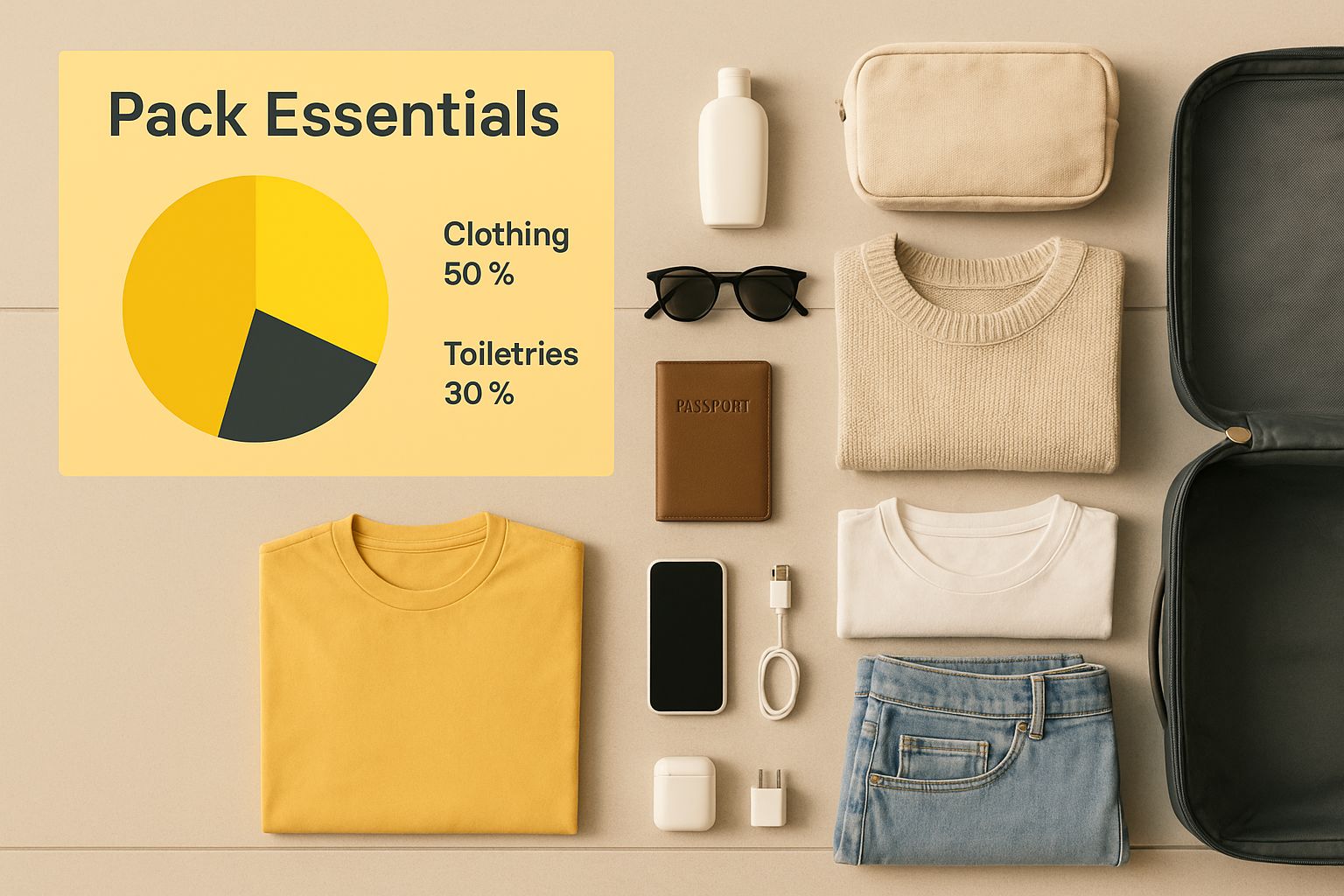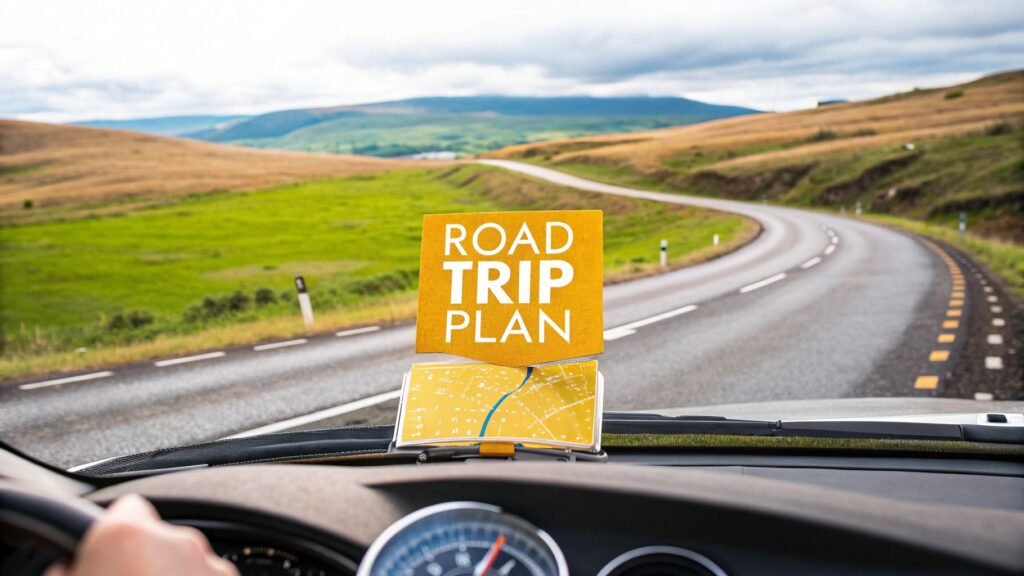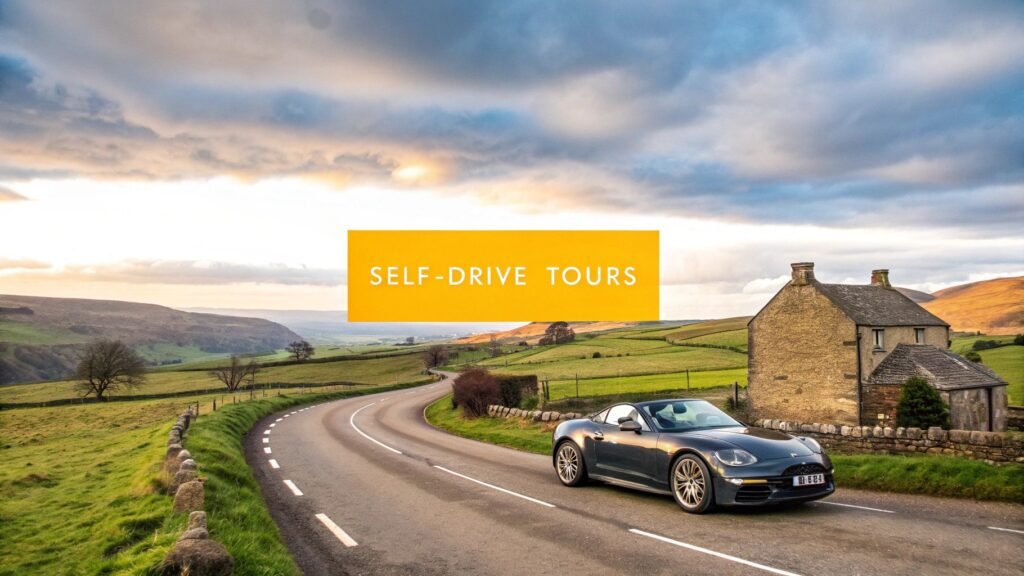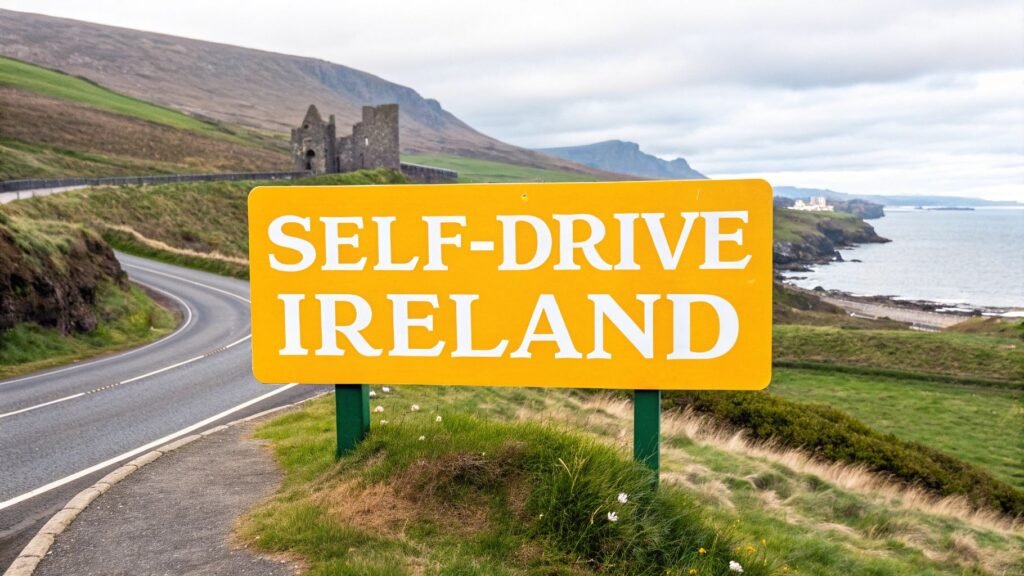Every great road trip I’ve ever planned started not with a map, but with a feeling. It’s about moving from that vague, exciting idea of “let’s just drive” to something with a real heart and soul. The secret how to plan road trips is nailing down the ‘why’ before you even think about the ‘where’.
Your Foundation for an Unforgettable UK Road Trip

The real magic of a UK road trip happens long before you turn the key. It starts right here, with building a solid foundation. This is where you transform a loose concept into a focused adventure with a clear purpose. Get this part right, and everything else just falls into place.
Define Your Trip’s Core Theme
First things first: what do you want from this trip? Are you dreaming of tracing ancient history through crumbling castles, getting lost in dramatic natural landscapes, or are you on a mission to find the UK’s best pub lunch? Your answer gives you a theme, and that theme becomes your north star for every decision that follows.
A strong theme is what stops your trip from becoming just a series of random drives. It gives your journey a story.
For instance, if you’re a literature buff, your path might wind through the postcard-perfect villages of the Cotswolds. But if it’s raw, untamed beauty you’re after, you’d be pointing your bonnet towards Scotland’s iconic North Coast 500. Each has a completely different feel that will shape your route, your stops, and your memories.
A well-defined theme is the compass for your road trip. It ensures every stop, detour, and experience aligns with your ultimate goal, turning a simple drive into a meaningful story.
Make Key Foundational Decisions
Once you’ve got your theme, a few practical questions naturally come next.
How much time can you realistically spare? The length of your trip—whether it’s a long weekend escape or a full-blown two-week expedition—sets the scale of your adventure. A three-day trip is brilliant for diving deep into one region, while a ten-day journey opens up the possibility of hitting multiple countries.
Then, think about who you’re travelling with. A solo trip means total freedom. A family holiday? That’s all about balancing different interests and energy levels. And if you’re heading out with friends, it’s absolutely crucial to get on the same page from the beginning. A quick chat about must-see spots and daily pacing can save a lot of headaches later on.
To see how these elements can click together, you can find some fantastic inspiration from our expertly curated self-drive tours through England, which are designed around different themes and travel styles.
By nailing down your theme, trip length, and travel crew upfront, you build a solid framework. This foundation doesn’t just make planning your route and budget easier—it makes the whole process genuinely exciting.
Designing Your Perfect Route and Itinerary

Right, this is the fun bit. This is where your road trip dreams start to take shape on a map. Think of it less as a strict, minute-by-minute schedule and more as a flexible framework for your adventure. It’s your guide from one amazing discovery to the next, with plenty of wiggle room built in for those spontaneous moments.
A good itinerary should feel liberating, not like a straitjacket. It’s also your best defence against the most common planning mistake I see: trying to do too much. Packing every single day to the brim just leads to clock-watching and rushing through places you wanted to savour. The real magic happens when you build in some breathing room.
This is all about balancing your absolute must-see sights with the freedom to pull over for a stunning view you didn’t expect or to wander through a charming village that wasn’t even on your radar. Honestly, it’s often those unplanned detours that become the stories you tell for years to come.
Pacing Your Journey Realistically
The secret to a truly relaxing road trip is getting the pacing right, and that starts with being realistic about driving times. It’s so easy to glance at a map, see a 150-mile stretch, and think, “Oh, that’s about three hours.” In reality, on winding country lanes or through bustling market towns, that same distance could easily stretch to five hours or more once you add in a few stops.
As a rule of thumb, I always suggest aiming for 2-4 hours of actual driving per day. This gives you plenty of time for leisurely meals, proper sightseeing, and taking advantage of those brilliant, unplanned opportunities.
Here’s a simple way to think about your day:
- Morning: Have a proper breakfast, maybe even a short walk around town, before you get behind the wheel.
- Midday: This is your main driving window. Aim to reach your next destination by mid-afternoon.
- Afternoon: Now you have a good few hours to check into your accommodation, explore your new surroundings, and find a nice spot for dinner without any sense of rush.
The best road trip itineraries are built around experiences, not just mileage. By limiting your daily drive time, you gift yourself the time to truly immerse yourself in the places you visit.
Blending Digital and Traditional Navigation
While modern navigation apps are brilliant, going all-in on digital can be a gamble, especially in the more rural corners of the UK where a phone signal is far from guaranteed. The smartest approach is to mix the best of the new with the reliability of the old.
Digital Tools:
- Google Maps or Waze: Perfect for live traffic updates, finding the fastest routes when you need them, and locating essentials like petrol stations and supermarkets. Their “download maps for offline use” feature is an absolute lifesaver.
- what3words: This app is a game-changer for finding precise spots that don’t have a postcode, like a specific car park for a trail or a hidden picnic spot by a loch.
Traditional Tools:
- Paper Maps: An old-school road atlas is your ultimate safety net. It never runs out of battery and doesn’t need a signal. More importantly, it gives you a far better “big picture” view of a region than a tiny phone screen, helping you spot those scenic routes (often marked with a green line) that a GPS might ignore in favour of a faster A-road.
I always start my own planning with a physical map spread out on the kitchen table. It helps me visualise the whole journey and spot those tempting B-roads that make the drive itself part of the adventure. Once I have a rough route sketched out, I’ll switch to digital tools to fine-tune the daily legs and pinpoint my overnight stops. This balanced strategy means you’re prepared for whatever the road throws at you.
Budgeting Smart for Your Journey
A great road trip is all about the memories you make, not the financial headache you come home to. Getting your budget right from the start is one of the most important parts of planning. It’s what separates a journey filled with spontaneous joy from one cut short by an unexpectedly empty wallet.
Think of your budget as a financial roadmap that runs parallel to your driving route. It’s not about restricting yourself; it’s about empowering yourself to say “yes” to the experiences that matter most, whether that’s a detour to a hidden cove or a meal at a pub you’ve heard whispers about for years.
Breaking Down Your Core Expenses
When I plan a trip, I find it helps to break down the costs into a few key areas. This way, nothing gets forgotten.
- Fuel: This can be a sneaky one. Your best bet is to map out your primary route to get a baseline mileage. But here’s a pro tip I’ve learned the hard way: always add an extra 10-15% to that total. You will take that scenic detour, get a little lost, or decide to explore a side road. Trust me.
- Accommodation: This is usually your biggest single expense. Whether you’re dreaming of boutique hotels, charming B&Bs, or sleeping under the stars at a campsite, booking ahead almost always saves you money and guarantees you a bed for the night.
- Food & Drink: Let’s be honest, this is half the fun of a UK road trip! I recommend a balanced approach. Budget for those must-try pub lunches and restaurant dinners, but also plan to hit a local supermarket for breakfast items, car snacks, and ingredients for a classic picnic.
- Activities & Entrance Fees: From Hadrian’s Wall to the Eden Project, entrance fees can add up quickly. Do a little online digging beforehand to check prices. Look out for multi-attraction passes, like those from English Heritage or the National Trust, which can offer brilliant value if you plan to visit several sites.
- The ‘Just-in-Case’ Fund: This isn’t optional; it’s essential. I always set aside 10-15% of the total trip cost as a contingency. This buffer is for the things you can’t plan for—a flat tyre, a last-minute theatre ticket, or that perfect piece of pottery you spot in a tiny village shop.
This image gives you a great visual checklist of the essentials you’ll be packing and, by extension, budgeting for.

Seeing it all laid out like this really drives home how every item, from your hiking boots to your camera, plays a part in the overall plan.
To give you a clearer picture of what to expect, here’s a sample breakdown of daily costs for a mid-range road trip across the UK.
Sample UK Road Trip Budget Breakdown (Per Person, Per Day)
This table provides estimated daily costs for a mid-range road trip in the UK to help you build a realistic budget. Costs can vary based on location and travel style.
| Expense Category | Low Estimate | Mid-Range Estimate | High Estimate |
|---|---|---|---|
| Accommodation | £40 | £80 | £150+ |
| Fuel (shared cost) | £15 | £25 | £40 |
| Food & Drink | £30 | £50 | £80+ |
| Activities & Entrance Fees | £10 | £25 | £50+ |
| Daily Total (Approx.) | £95 | £180 | £320+ |
Remember, these are just estimates! A trip focused on London will look very different from one exploring the Scottish Highlands. Use these figures as a starting point and adjust them to fit your personal travel style.
Savvy Spending on the Road
Keeping an eye on travel trends can also help you be smarter with your money. For instance, recent figures show that while domestic trip numbers are up, many people are opting for shorter getaways. The average spend for a holiday trip in England was recently around £251, a number heavily influenced by popular 1-3 day breaks. This tells us that a well-planned, shorter tour can be a fantastic and cost-effective way to explore.
A smart budget isn’t about restricting your fun; it’s about enabling it. By planning your spending, you give yourself the freedom to enjoy every moment without financial worry.
If you’re mapping out a longer adventure, looking at pre-built itineraries can be a huge help in gauging costs. A journey like our 8-day Taste of England self-drive tour, for example, gives you a real-world look at how accommodation, daily drives, and key sights come together in a package. It makes it so much easier to get a feel for what you might spend each day.
A little financial planning now paves the way for a journey that’s as affordable as it is unforgettable.
Getting Your Vehicle Road-Trip Ready
On a road trip, your car isn’t just a way to get from A to B—it’s your base of operations, your trusty steed, and your ticket to freedom. Making sure it’s in top-notch condition before you hit the road is one of the most important things you can do for a seamless adventure. I always recommend giving your car a thorough check-up at least a week or two before you’re due to leave.
A great way to remember the basics is the old acronym, ‘FORCES’—that’s Fuel, Oil, Rubber, Coolant, Electrics, and Screenwash. Top up all your fluids, and pay close attention to your tyres. Check the tread depth and, crucially, make sure they’re inflated to the correct pressure for a fully loaded vehicle. Don’t forget to test all your lights and windscreen wipers; you never know when you’ll need them.
Your Roadside Safety Net
It’s no secret that UK tourism is booming. With inbound foreign visits forecasted to hit 12.5 million in a single quarter—a huge jump from previous years—our roads are only getting busier. More cars on the road mean a greater chance of running into delays or needing a bit of help, which makes vehicle reliability absolutely paramount.
This is exactly why having solid breakdown cover and a well-stocked emergency kit is a must. It’s your safety net. Your kit should include:
- Jump leads
- A high-visibility jacket
- A warning triangle
- A torch (and don’t forget the spare batteries!)
- A basic first-aid kit
And, of course, before you go anywhere, double-check that your insurance is up to scratch. This expert guide to choosing car insurance is a fantastic resource if you need a little help navigating your options.
Peace of mind is the most important thing you can pack. A well-maintained car and a solid backup plan mean you can handle minor hiccups without them derailing your adventure.
Finally, a bit of thought into how you pack the car can make all the difference. Boot organisers and storage boxes are brilliant for keeping luggage secure and stopping things from sliding about. For the front, I find a small caddy is perfect for holding snacks, charging cables, and your phone within easy reach. A tidy car really does create a calmer, more enjoyable space, which is exactly what you want on one of our amazing self-drive tours.
Packing Smart for Unpredictable UK Weather
Packing for a UK road trip is an art form, mainly because the weather loves to throw a bit of everything at you – sometimes all in the same afternoon. Sunshine, sudden showers, and a stiff breeze are all part of the charm. The real trick isn’t to pack for every single possibility, but to pack smart. It’s all about mastering the layering system to stay comfortable without sacrificing that precious boot space.
The foundation of any good UK packing list is layers. Forget bulky jumpers; think in terms of multiple thin layers you can peel off or pile on. This gives you the flexibility to adapt on the fly, whether you’re exploring a windswept clifftop or wandering through a sun-drenched village.
The Essential Layering System
Your clothing choices should really revolve around three core layers:
- Base Layer: Start with a moisture-wicking t-shirt or long-sleeved top. This draws any sweat away from your skin, which is key to staying dry and comfortable.
- Mid-Layer: This is all about insulation. A lightweight fleece or a thin wool jumper is perfect for adding warmth without the bulk.
- Outer Layer: A waterproof and windproof jacket is completely non-negotiable. Seriously, this is your shield against the elements and probably the most important thing you’ll pack.
Beyond the clothes on your back, a few other items can make a world of difference. With UK tourism projected to welcome 43.4 million inbound visitors, being a little self-sufficient can ease the strain on busy local spots. Packing things like a reusable water bottle, a portable power bank for your phone, and a basic first-aid kit means you’re always prepared. You can dive deeper into how tourism is shaping UK travel by checking out these industry statistics.
A smart traveller anticipates their needs. Packing essentials not only makes your trip smoother but also makes you a more considerate visitor, reducing your footprint in popular areas during peak seasons.
Organise for Easy Access
Finally, let’s talk about organisation. Don’t just chuck everything into one big suitcase and hope for the best. A brilliant strategy I’ve learned over the years is to use a dedicated ‘day bag’ that lives in the car with you.
This smaller bag should hold everything you might need at a moment’s notice: your waterproof jacket, phone, power bank, snacks, water, and maybe even a physical map for those no-signal moments. This simple habit saves you from the classic car park rummage every time the weather turns or your phone battery dies. Your main luggage can stay neatly packed in the boot, only making an appearance when you check into your accommodation for the night. This is how you plan a road trip like a pro, keeping the whole journey organised and wonderfully stress-free.
Your UK Road Trip Questions Answered
Even with the most meticulous plan, a few practical questions always pop up just before you head out. It’s completely normal. Planning a road trip, especially somewhere as diverse as the UK, often comes down to getting these final details right. We’ve gathered the most common queries we get from fellow travellers to give you clear, straightforward answers and help you finalise your plans with total confidence.
When Is the Best Time of Year for a UK Road Trip?
This really boils down to what you’re hoping to experience. For the best all-around trip, I always recommend late spring (May-June) or early autumn (September-October). You hit that sweet spot of milder weather and longer days, but you cleverly miss the peak summer crowds of July and August. These “shoulder seasons” are often kinder on the wallet, too, especially when it comes to booking accommodation.
That said, every season has its own unique magic:
- Summer (July-August): This is your time for classic coastal drives in Cornwall or Pembrokeshire and for getting out into the national parks. Just be ready for busier roads and be sure to book everything well ahead of time.
- Winter (November-February): There’s something truly special about a drive through the snow-dusted Scottish Highlands. It’s magical, but you’ll need to be prepared for the cold, potential snow, and much shorter daylight hours.
Ultimately, the “best” time is simply the one that fits the trip you’re dreaming of.
How Should I Tackle Driving in UK Cities?
Let’s be honest: driving in a major UK city can be a nightmare. Between the congestion, ancient narrow streets, and confusing driving zones, it can test the patience of even the calmest driver. Many cities now have special zones to manage traffic and pollution, which you need to be aware of.
London, for instance, has its infamous Congestion Charge and the even wider Ultra Low Emission Zone (ULEZ). You’ll also find Clean Air Zones (CAZ) in cities like Bristol, Birmingham, and Glasgow. Before you even think about driving into a city centre, check the official government websites to see if your vehicle will incur a charge.
My best advice? Use the ‘park and ride’ system. It’s the most stress-free way to explore a city. Find a designated car park on the outskirts and hop on public transport to get into the centre. You’ll save yourself the headache of navigating chaotic streets and avoid the risk of a surprise fine in the post.
What Are the Must-Have Apps for a UK Road Trip?
Having the right apps on your phone can make a huge difference to how smoothly your journey goes. I’d never travel without a paper map as a backup, but these digital tools are brilliant for the day-to-day stuff.
- Navigation: Google Maps or Waze are non-negotiable. The live traffic updates alone will save you from countless hours stuck in queues.
- Precision Location: I love what3words for finding those tricky spots that don’t have a postcode, like a specific trailhead in a forest or that perfect viewpoint you read about.
- Parking: Apps like JustPark or RingGo are lifesavers. They’re used all over the UK and make paying for parking ridiculously easy.
- Fuel Savings: Using an app like PetrolPrices can help you scout out the cheapest petrol stations along your route. The savings can add up over a long trip.
And of course, staying connected is a big one for modern road-trippers. It’s worth looking into different internet options for RV travel to make sure you can always get online, whether you’re booking a last-minute campsite or checking the weather forecast.
How Much Should I Budget for Petrol?
Fuel is going to be one of your biggest and most unpredictable expenses. But with a bit of quick maths, you can get a pretty solid estimate.
First, work out your car’s average miles per gallon (MPG). Then, use a route planner to get the total mileage for your trip. I always add an extra 15% on top of that to cover those spontaneous detours and side quests you’ll inevitably take.
Divide your total estimated mileage by your car’s MPG to figure out how many gallons you’ll need (remember, one UK gallon is about 4.54 litres). Then, just check a reliable source for current UK petrol or diesel prices and multiply it out. For a 1,000-mile trip in a car that gets around 40 MPG, you’re looking at 25 gallons (roughly 114 litres), which could easily set you back £160-£180.
Feeling inspired to hit the open road? At BTOURS, we specialise in creating unforgettable self-drive adventures across the UK. Let us handle the details so you can focus on the discovery. Explore our curated tours at https://www.btours.com.



